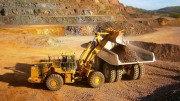The following is an edited summary from the Prospectors & Developers Association of Canada report, State of Mineral Finance 2018: Gaining Momentum. For more information and to read the full report, visit www.pdac.ca.
After a prolonged downturn in mineral industry activity, 2016 and 2017 were characterized by rising commodity prices that sparked increased financing opportunities and exploration expenses, both in Canada and globally. A cyclical upswing in global economic activity, coupled with U.S. dollar depreciation and low interest rates, has driven an improvement in the commodity complex. However, improvements in financing and exploration activity have not spread evenly across the mineral industry.
The International Monetary Fund (IMF) estimates for global economic growth — measured by gross domestic product (GDP) — have rebounded from a low of 3.2% in 2016 to 3.7% in 2017, and could increase to 3.9% through 2018–2019. A rebound in global GDP combined with higher expectations for growth in China and other advanced economies, as well as U.S. domestic infrastructure spending, are likely drivers behind increased demand for industrial commodities. As a result, monthly average prices of key base metals improved significantly over the past two years (36–110%), while monthly average prices for precious metal have experienced more modest increases (6–15%) over the same period.
Global mineral sector investment deteriorated from a peak in 2012 through to 2016, as funds raised globally for the mineral sector declined 56% compared to 2012 levels. This trend reversed in 2017, as total global financing increased 61% year-over-year. The relative increase is largely attributed to increased debt financing, which doubled between 2016 and 2017. Given that debt is not a typical financing vehicle for non-revenue generating exploration companies, debt expansion may suggest that a shift in market dynamics for the mineral industry is underway.
Global equity financing peaked in 2011 at US$53 billion and fell sharply to reach US$24 billion in 2013. Global equity financing has stabilized but with a moderate decreasing trend, declining from US$37 billion in 2014 to US$27 billion in 2016, and slightly improving to US$29 billion in 2017. Canadian stock exchanges continue to be a material source of equity financing for the global mineral industry, with TSX and TSXV contributing on average 19% of the funds raised from 2011 to 2017.
Mineral industry financing via Canadian stock exchanges in 2017 expanded 83% from a 2015 low. Total financing activity was more prominent on the TSXV, with a 243% increase over two years, compared to 64% on the TSX. Most of the increases occurred in 2016, and, similar to the global trend, most funding expansion is attributed to an increase in debt financing, which rose from $0.5 billion in 2015 to $6.6 billion in 2017, or 52% of total funds raised.
Data provided by Oreninc on junior mineral industry financing in Canada shows a mixed picture for 2017. Equity raises by junior companies listed on the TSXV increased 18% compared to 2016, while the CSE recorded a 123% increase in funds raised. Conversely, the value of financing for junior companies on the TSX declined 32% from 2016 levels. In 2017, bought-deal transactions became more significant, with their value increasing 12%, while the value of best-effort transactions fell 21% and 15% for brokered and non-brokered transactions. Lastly, while the value of equity financing for projects targeting minerals associated with battery-technology grew 200% in 2017, the same fund flow for both precious and base metals fell 12% and 11%, respectively. Over 85% of funds generated via equity financing for junior companies was by those with a market capitalization of less than $500 million.
Global financing explicitly for mineral exploration from 2012 to 2015 was negatively impacted by lower overall investment in the mineral industry, and declined 85% from US$19.4 billion to US$2.9 billion over this period. Between 2015 and 2017 financing for exploration nearly tripled to reach US$4.8 billion in 2016 and US$8.9 billion in 2017. In Canada, similar trends are observed with a 75% decline in financing for exploration between 2012 and 2015, followed by an increase of nearly 200% between 2015 and 2016 (from $1.02 billion in 2015 to $3 billion in 2016), and a further 7% increase in 2017.
Global exploration expenses from 2012–2017 followed exploration financing trends, declining over 65% from a peak of US$20.5 billion in 2012 to US$6.9 billion in 2016. The trend reversed in 2017 as expenses increased 15%, compared to 2016 (to US$7.9 billion). Canada and Australia continued to lead global activity in 2017, accounting for 13.8% and 13.5% of expenses, respectively. Noteworthy is a long-term decline in Canada’s share of global exploration spending, from 20.5% in 2008 to 13.8% in 2017.
The profile of Canadian exploration expenses followed global trends, peaking in 2012 at $3.2 billion, declining nearly 60% to $1.3 billion in 2016 and rebounding 10% in 2017. Analyzing expenses based on the stage of project development highlights a somewhat alarming long-term trend of grassroots exploration representing a decreased share — from 45% of exploration expenses in 2008 to 21% in 2016, before slightly improving to 28% in 2017.
The flow-through share (FTS) regime continues to be a critical source of exploration financing in Canada. From 2011–2017, funds raised in Canada for domestic exploration via FTS financing averaged 68% of the total funds generated.






Be the first to comment on "Financing uptrend continues, PDAC report says"